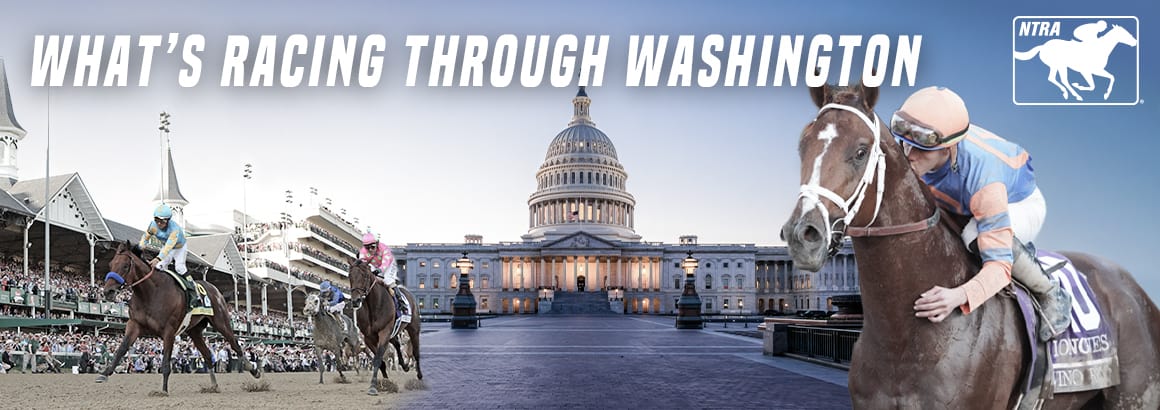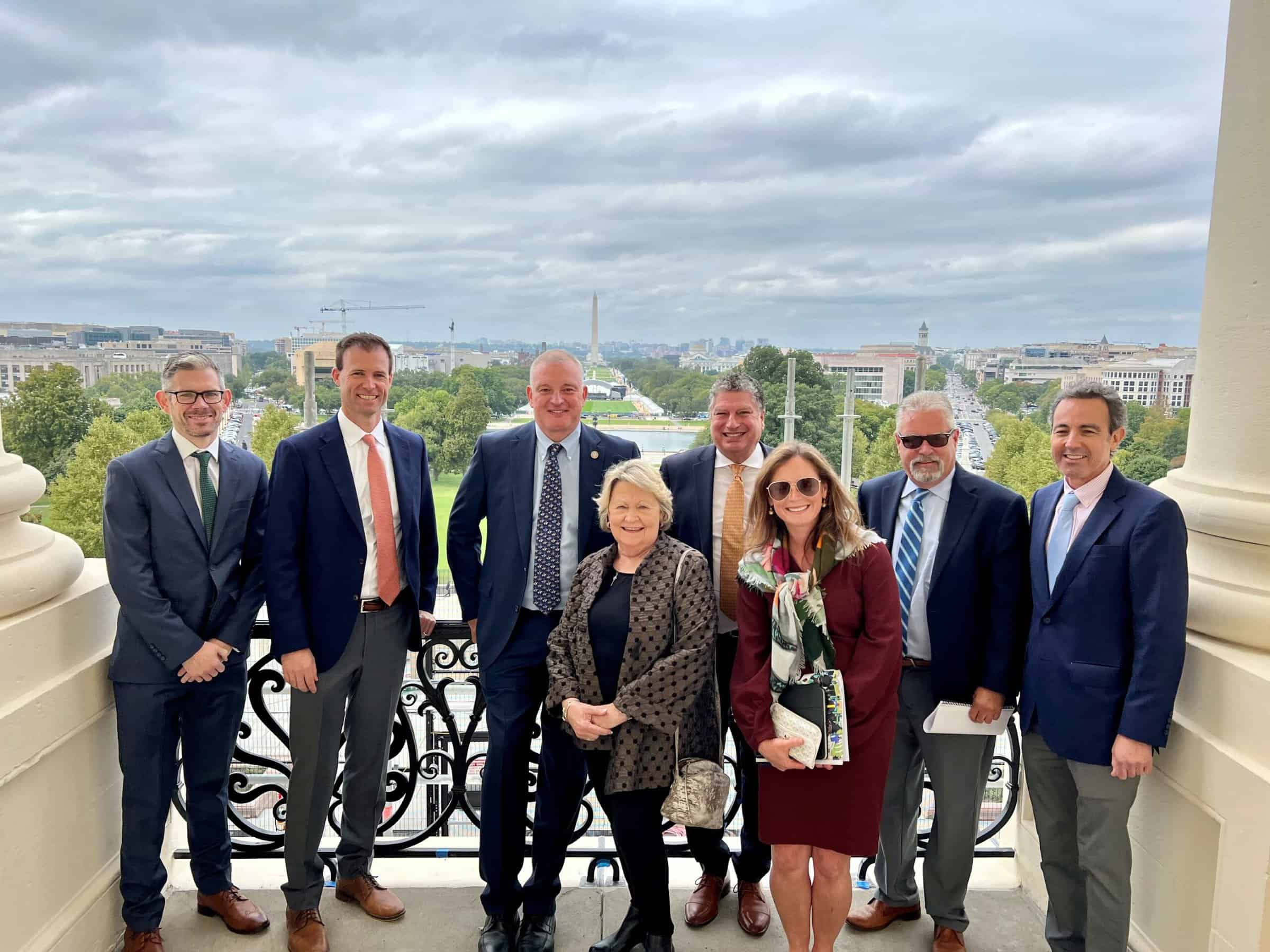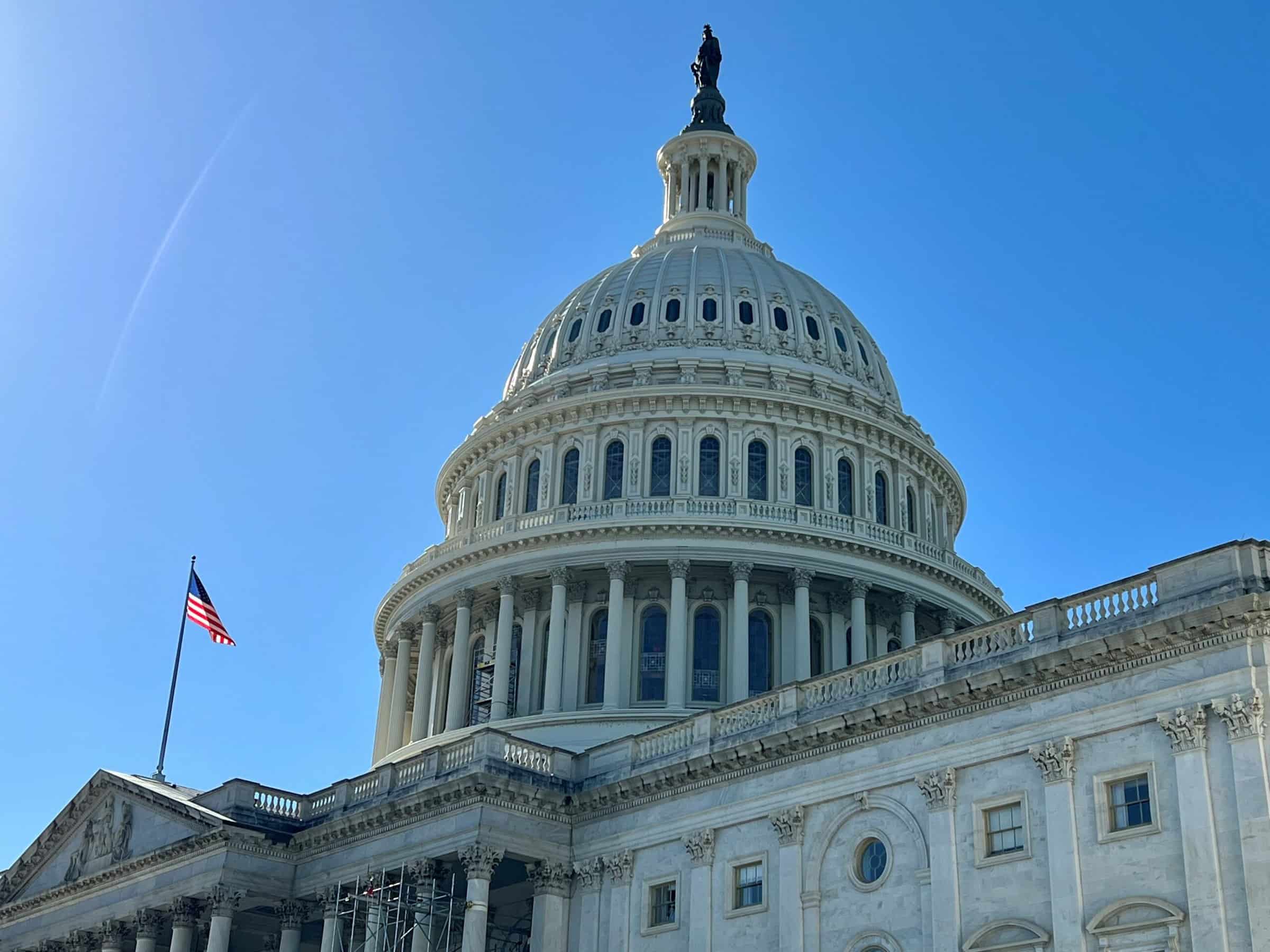
Welcome to NTRA’s What’s Racing Through Washington newsletter, your one-stop source for all things Thoroughbred racing in Washington, D.C. As we transition into the autumn season, Congress is gearing up for crucial end-of-year legislation that could significantly influence our industry. We hope you’ll find the newsletter informative, and we eagerly anticipate further discussions with you on matters affecting the Thoroughbred industry.

NTRA President and CEO Tom Rooney with members of the NTRA Board on the Speaker’s Balcony at the U.S. Capitol during a recent visit to Washington, D.C.
Uncertainty for House Speakership Intensifies
The House Republican leadership is preparing for another speaker vote scheduled for around noon today. However, in the absence of a candidate commanding a solid majority, Democrats are looking to formalize discussions with their Republican counterparts this week to explore a potential bipartisan solution for selecting a speaker. Democratic Leader Hakeem Jeffries (N.Y.) expressed their readiness to collaborate during an interview, emphasizing that Democrats aren’t making any specific demands in these discussions. They do, however, express a desire to modify House rules to enable measures with bipartisan support to be considered for a vote. This situation unfolds following the nomination of Rep. Jim Jordan (Ohio) as the House speaker candidate by the Republicans. This nomination marks the second attempt by the divided party to replace the removed GOP leader, Kevin McCarthy (Calif.). Nevertheless, a secret ballot conducted immediately after Jordan’s nomination on Friday, October 13, revealed that he falls significantly short of the 217 votes required for election. A group of Republicans strongly opposed to Jim Jordan is determined to put forward a challenger during the House floor speakership vote. While they haven’t yet settled on a specific candidate, they believe that the chosen contender will not only have the potential to prevent Jordan from becoming the speaker but also provide cover for those who wish to vote against him. This challenge is anticipated to face resistance from the far-right segment of the conference that strongly supports Jordan. It adds another layer of complexity to Jordan’s already challenging bid to secure the necessary 217 votes on the House floor.
USCIS Reaches H-2B Cap for First Half of FY 2024
US employers submitted enough petitions for seasonal H-2B work visas to exhaust the cap for the first half of the 2024 fiscal year, US Citizenship and Immigration Services announced on Friday, October 13. The H-2B program allows employers to add foreign workers for temporary non-farm jobs, which include positions such as those on the backstretch. The visas, which have a duration of three years, are limited to 66,000 annually. H-2B petitions are exempt from the cap if workers already in the US are extending their stay or changing their employment. The Biden Administration in recent years has issued an increasing number of supplemental H-2B visas beyond the annual allotment in response to employer demand, reaching the discretionary cap for the first time in the past fiscal year with nearly 65,000 visas. An effort to pass a cap exemption for returning H-2B workers fell short this year in the Congressional Appropriations process.

NTRA Joins Close to 500 Businesses and Trade Associations in Expressing Support for 100% Bonus Depreciation
Next week, the National Thoroughbred Racing Association (NTRA), in conjunction with nearly 500 other businesses and trade associations, will collectively send a letter to the leadership of both the House and the Senate. This letter will convey their strong support for the permanent establishment of the 100% bonus depreciation as an incentive within the tax code. Throughout the past several decades, the tax code has offered businesses varying opportunities for first-year expensing, commonly referred to as accelerated depreciation. The availability of a 100% deduction for equipment, machinery, and even horse purchases made in the tax year was a policy in effect from 2017 through 2022. This initiative was introduced by Congress to stimulate investments and ensure that the United States remains attractive for capital infusion in a fiercely competitive global market. However, the 100% bonus provision began to phase out at the start of 2023 and is set to be completely eliminated by 2027. According to the non-partisan Joint Committee on Taxation (JCT), policies promoting accelerated depreciation have a pronounced positive impact on investment, especially within small businesses. JCT’s research also revealed that industries with the largest workforces, such as manufacturing, agriculture, communications, wholesale, and retail trade, have been most effective in harnessing accelerated depreciation to reinvest in their respective companies. In light of these findings, it is imperative for Congress to act promptly to reinstate 100% bonus depreciation, as a failure to do so will result in increased costs for businesses pursuing job-creating investments in the United States.
Read the full letter HERE.
USDA Provides an Update to Equine Testing During Import Quarantine
The U.S. Department of Agriculture’s (USDA’s) Animal and Plant Health Inspection Service (APHIS) has recently issued an update to its Veterinary Services Guidance (VSG) 13407.3, which pertains to the testing of equines during their import quarantine. This update serves to provide clarity on specific definitions, introduce a new testing procedure for glanders, and enhance import controls related to tick-borne diseases, notably equine piroplasmosis. As of October 10, 2023, APHIS has actively implemented and is enforcing this revised VSG across all equine import quarantine facilities.
Below is a summary of the revised guidance:
- Refinement of Definitions: The updated VSG brings precision to the definition of “non-negative” test results and introduces a new classification for import purposes. It also makes modifications to the definition of confirmatory testing. These changes are aimed to eliminate ambiguity and ensure that animals with non-negative test results are appropriately handled in quarantine.
- Glanders Testing Protocol: A new testing protocol for glanders has been introduced, aimed at minimizing the possibility of false positive results without incurring additional costs for submitters. The National Veterinary Services Laboratories (NVSL) will now employ the double antigen enzyme-linked immunosorbent assay (daELISA) as the official test for glanders. This test is more sensitive and specific compared to the existing complement fixation test (CFT). The daELISA results are binary, being either positive or negative, with no “suspect” outcomes. If daELISA results turn out positive, NVSL will conduct a Western blot as a confirmatory test. Horses testing negative in the Western blot confirmatory test will be classified as free from glanders and may be released.
- Equine Piroplasmosis and Ticks: Provisions have been included to ensure that horses entering import quarantine with attached ticks are free from equine piroplasmosis and are not incubating the disease at levels below the diagnostic test’s sensitivity. Specifically, the VSG stipulates that horses found with attached ticks during import inspection must either undergo a fourteen-day quarantine and retesting for piroplasmosis or be refused entry.
- Cohort Definitions: The guidance revises the definitions of cohorts for equine piroplasmosis and dourine to encompass all horses residing on the same premises within the sixty days immediately preceding export. This includes horses that were present concurrently or subsequent to a horse within the same shipment that tested non-negative for piroplasmosis and/or dourine.
It is important to highlight that the NTRA has been in ongoing discussions with the USDA concerning testing protocols and is encouraged by the USDA’s responsiveness to our input, resulting in essential adjustments to the glanders testing protocol. The NTRA remains committed to championing policies that enhance the welfare of the equine community.
For more information and regular updates please visit www.ntra.com.
